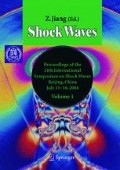Abstract
We demonstrate an end-to-end computational model of the HEG shock tunnel as a way to extract more precise test flow conditions and as a way of getting predictions of new operating conditions. For a selection of established operating conditions, the Lid program was used to simulate the one-dimensional gas-dynamic processes within the whole of the facility. The program reproduces the compression tube performance reliably and, with the inclusion of a loss factor near the upstream-end of the compression tube, it provides a good estimate of the equilibrium pressure in the shock-reflection region over the set of six standard operating conditions for HEG.
Access this chapter
Tax calculation will be finalised at checkout
Purchases are for personal use only
Preview
Unable to display preview. Download preview PDF.
erences
M. K. Mcintosh: Computer program for the numerical calculation of frozen and equilibrium conditions in shock tunnels. Department of Physics Unpublished Technical Report, Australian National University, Canberra, 1968
J. A. Copper: Experimental investigation of the equilibrium interface technique. The Physics of Fluids 5(7), 844 (1962)
J. Mclntyre, J. R. Maus, M. L. Laster, and G. Eitelberg: ‘Comparison of the Flow in the High-enthalpy Shock Tunnel in Göttingen with Numerical Simulations’. In: Proceedings of the 19th ISSW, Volume 1, Berlin, July 1993, R. Brun and L. Z. Dumitrescu, editors, (Springer-Verlag) pp.251-256
K. Itoh, K. Tani, H. Tanno, M. Takahashi, Miyajima H., T. Asano, A. Saso, and K. Takayama: ‘A Numerical and Experimental Study of Free Piston Shock Tunnel’. In: 19th International Symposium on Shock Waves, Marseille Prance 1993
K. Tani, K. Itoh, M. Takahashi, H. Tanno, T. Komuro, and H. Miyajima: Numerical study of free-piston shock tunnel performance. Shock Waves 3, 313 (1994)
K. Itoh, S. Ueda, T. Komuro, K. Sato, M. Takahashi, H. Miyajima, H. Tanno, and H. Muramoto: Improvement of a free piston driver for a high-enthalpy tunnel. Shock Waves 8, 215 (1998)
H. Tanno, K. Itoh, T. Komuro, and K. Sato: Experimental study on the tuned operation of a free piston driver. Shock Waves 10, 1 (2000)
J. Maus, J. Blanks, and J. Dewitt: Calibration tests of a new free-piston shock tunnel. AIAA Paper 93-5003 (1993)
J. Lacey and D. Long: A wave diagram computational method with application to a free-piston shock tube. AIAA Paper 90-1378 (1990)
J. Maus, M. Laster, and H. Hornung: The G-range impulse facility. A high-performance free-piston shock tunnel. AIAA Paper 92-3946 (1992)
L. Labracherie, M. P. Dumitrescu, Y. Burtschell, and L. Houas: On the compression process in a free-piston shock-tunnel. Shock Waves, 3(1), 19 (1993)
P. A. Jacobs: Quasi-one-dimensional modelling of a free-piston shock tunnel. AIAA Journal 32(1), 137 (1994)
P. A. Jacobs: L1d: A computer program for the simulation of transient-flow facilities. Department of Mechanical Engineering Report 1/99, The University of Queensland, Brisbane, Australia, January (1999)
P. J. Petrie-Repar and P. A. Jacobs: A computational study of shock speeds in high performance shock tubes. Shock Waves 8(2), 79 (1998)
P. A. Jacobs, R. G. Morgan, R. J. Stalker, and D. J. Mee: ‘Use of Argon-helium Driver-gas Mixtures in the T4 Shock Tunnel’. In: 19th International Symposium on Shock Waves, Marseille, Prance. (Springer-Ver lag, 1993)
S. P. Sharma and G. J. Wilson: Computations of axisymmetric flows in hypersonic shock tubes. AIAA Journal of Thermophysics and Heat Transfer 10(1), 169 (1996)
R. S. M. Chue and G. Eitelberg: Studies of the transient flows in high enthalpy shock tunnels. Experiments in Fluids 25, 474 (1998)
G. Eitelberg: First results of calibration and use of the HEG. AIAA Paper 94-2535 (1994)
P. A. Jacobs, A. D. Gardner, and K. Hannemann: Gas-dynamic modelling of the HEG shock tunnel. Report DLR-IB 224-2003 A02, Deutsches Zentrum für Luft-und Raumfahrt E.V., Göttingen, Germany, January 2003
B. J. McBride and S. Gordon: Computer program for calculation of complex chemical equilibrium compositions and applications II. Users manual and program description. Reference Publication 1311, NASA, June 1996
T. J. Mclntyre and C. Atcitty: Pistons and compression tubes— piston motions in the high enthalpy shock tunnel (HEG). Report IB222-90A20, Institute of Experimental Flow Mechanics, DLR, Göttingen, March 1991
K. Hannemann, J. Martinez Schramm, S. Karl, and W. Beck: Cylinder shock layer density profiles measured in high enthalpy flows in HEG. AIAA Paper 2002-2913 (2002)
K. Hannemann, V. Hannemann, S. Brück, R. Radespiel, and G.S.R. Sarma: ‘Computational Modelling for High Enthalpy Flows’. In: SAMS Vol. 34. (Overseas Publishers Association, 1999), pp.253–277
Author information
Authors and Affiliations
Editor information
Editors and Affiliations
Rights and permissions
Copyright information
© 2005 Tsinghua University Press and Springer-Verlag Berlin Heidelberg
About this paper
Cite this paper
Jacobs, P.A., Gardner, A.D., Buttsworth, D.R., Martinez Schramm, J., Karl, S., Hannemann, K. (2005). End-to-end modelling of the HEG shock tunnel. In: Jiang, Z. (eds) Shock Waves. Springer, Berlin, Heidelberg. https://doi.org/10.1007/978-3-540-27009-6_46
Download citation
DOI: https://doi.org/10.1007/978-3-540-27009-6_46
Published:
Publisher Name: Springer, Berlin, Heidelberg
Print ISBN: 978-3-540-22497-6
Online ISBN: 978-3-540-27009-6
eBook Packages: Physics and AstronomyPhysics and Astronomy (R0)

